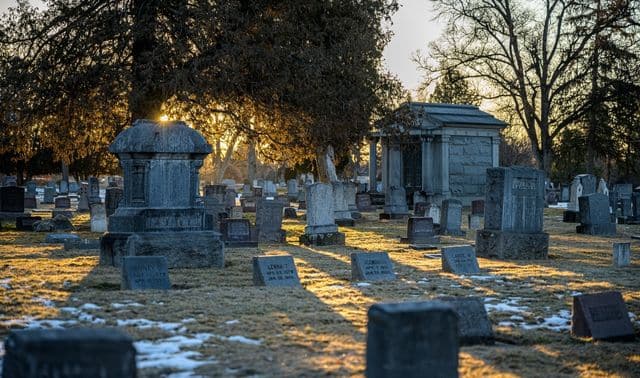Sign up for the Family Tree Newsletter Plus, you’ll receive our 10 Essential Genealogy Research Forms PDF as a special thank you!
Get Your Free Genealogy Forms
"*" indicates required fields

If your ancestor died from about the late-19th century forward, you may easily learn where that person was buried through home sources such as funeral cards and oral history. Death certificates and obituaries traditionally carry this information, too. If not, but a funeral home is given, contact them: Check the American Blue Book of Funeral Directors, available in most public libraries’ reference section. If the funeral home no longer exists, contact the local or state historical society or local public library to see if they know what happened to the records.
For ancestors who died earlier, discovering grave sites may require more creativity. You need to know the locality where the ancestor died, since chances are that was also where the person was buried. Because genealogists have that fascination with cemeteries, many individuals and organizations have fully transcribed cemetery information and published the results—so look in the locality where your ancestor died for a published cemetery transcription. Check the catalog of the Family History Library at www.familysearch.org/search/searchcatalog.asp for the locality, followed by “cemetery.” This library has perhaps the largest collection of published cemetery transcriptions; those on microfilm you can borrow through your local Family History Center. More and more cemetery and tombstone registries are popping up on the Internet, too (see links here).
Another resource to try is published family histories. If your ancestor is included in a published family history, an earlier genealogist may have located the grave and recorded its whereabouts. If you know the ancestor’s religious affiliation, try contacting the churches in the area. To see if cemetery records exist, try writing directly to the cemetery sexton (if the cemetery is still active) or to the town hall or county courthouse where the cemetery is located.
Also try the US Geological Survey’s Geographic Names Information System on the Web at mapping.usgs.gov/www/gnis/gnisform.html. Type in the locality and “cemetery” in the “Feature Type,” and this will give you a list of cemeteries in that area.
Finding the right cemetery also depends in part on what kind of cemetery it is. At least eight different categories of cemeteries exist, according to Kenneth T. Jackson and Camilo José Vergara’s Silent Cities: The Evolution of the American Cemetery (out of print):
- Church graveyard.
- Family burial plots.
- Country cemetery.
- Elite garden cemetery.
- Ordinary urban cemetery.
- Veterans cemetery.
- Memorial park.
- Potter’s field.
These were our country’s first cemeteries. In Europe, the elite were buried inside the church under the stone floor. In America, this wasn’t feasible because the churches were so much smaller, so everyone was buried outside.
These were on private property and may be difficult to locate today if the cemetery hasn’t been maintained and isn’t well known in the community. Many genealogical societies have a cemetery committee, which not only transcribes tombstones in local cemeteries, but also attempts to locate and document family burying grounds. Check with the local genealogical society for hard-to-find grave sites, and look under your ancestor’s county on the USGenWeb site, www.usgenweb.org, for contacts and possibly lists of family plots in the area.
These are the ones you see as you drive down the “blue highways” of America. They often contain homemade or mail-order markers.
The garden-type cemetery began in the early 19th century; Mount Auburn Cemetery in Cambridge, Mass., was the first of its kind in 1831. These cemeteries are park-like, containing pathways, ponds, trees, foliage and benches. Before we had public parks, this is where people went on Sunday afternoons to picnic, contemplate and take afternoon strolls.
These might look like a “stone yard.” They’re just rows and rows of tombstones with straight paths and little foliage.
These are for the honorably discharged and their families. The United States has 117 national veterans cemeteries; Arlington Cemetery is the most well-known. To locate an ancestor who was buried in a veterans cemetery, write to the National Cemetery Administration (402B), Burial Location Request, Department of Veterans Affairs, 810 Vermont Ave., Washington, DC 20420. Include the ancestor’s full name, date and place of birth and death, from which state he or she entered active duty, and military service branch. The records are indexed.
These are flat, grassy lawns with barely any visible evidence that people are buried there. The tombstones are flat and flush with the ground, containing the name of the deceased and usually just a birth and death year.
This is where the county or city buries the poor, the unknown and the unwanted. If your ancestor fell into one of those categories, you’re probably out of luck.
ADVERTISEMENT




